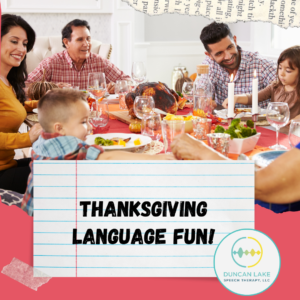Thanksgiving brings with it a lot of time for family togetherness, food, and of course, opportunities of learning language! Looking for ways to incorporate some language-enriching activities into your holiday? Look no further!
MEAL PREPARATION
-
Following Directions
-
Have the kiddos in your house help with meal prep. Have them follow 1 and 2 step directions. For an extra challenge, give them directions and have them repeat it back to you in their own words. Older kids can read the recipes themselves (or with help) and, with guidance, can have a lot of independence in this task.
-
-
Prepositions
-
Cooking lends itself well to prepositions. Instruct and model prepositions like “in” (“Put it in the bowl.”), “on” (“Set the bowl on the counter.”), and “next to” (“The sugar is in the cupboard next to the sink.”).
-
-
Actions
-
The number of actions that can be modeled while cooking and baking is ENDLESS. Model familiar actions such as “stir,” “shake,” “bake,” and “cook,” as well as less known actions such as “sift” and “baste.” If you’re comfortable with their help, have your child participate in the actions with you. You can also have them bring their play food to pretend “chop” and “slice” if you’d rather not have your 4 year old wielding a kitchen knife.
-
-
Vocabulary
-
A lot of cooking and baking vocabulary isn’t super familiar to little kids. While you’re baking and cooking, talk about the different ingredients you’re adding to your creations. Measurements, such as “teaspoon,” “ounces,” and “cup,” are great to model. If you have older kids and happen to have a wanna-be Gordon Ramsey around your house (AKA my husband at our Thanksgivings), fancy cooking words like “roux” or “emulsion” can be fun challenge words for kids to bust out at school when they get back from break!
-
-
Modeling Sentences
-
Narrate what you’re doing in full sentences. Good sentence models are essential for language development. For example, you can say, “I’m mixing the stuffing,” or “I’m chopping up the vegetables for dinner.”
-
-
AAC
-
Pull up the food page and go to town! Talk about the different foods/ingredients you’re making/using by modeling it on the device and having the kiddo indicate their food preferences (“I like pumpkin pie.”). Modeling and practicing actions and prepositions can be easily done on devices during cooking as well!
-
Core words: In, on, more, on, need, like
-
-
Cooking is also a great way to include relatives with progressive-degenerative illnesses. Older family members with dementia can participate by being given small task like snapping the green beans and mixing ingredients. They can also not participate and just be included in the fun conversations that surround food creation.

MACY’S THANKSGIVING DAY PARADE
-
Actions
-
The actions that can be described and modeled at the Macy’s Thanksgiving Day Parade are pretty different from the ones you modeled while cooking! Talk about how the balloons “float/fly,” the parade participates “march” and “cheer,” and (my favorite) the Broadway casts “dance” and sing!” Have your kids mimic the actions they see, even if that means you have to hear “Baby Shark” for the 1,000,000,000th time (sorry).
-
-
Vocabulary
-
Vocabulary from the parade is a lot of fun for kids, largely because it includes their favorite characters. Go with it! Add in fun words like “parade float” and “spectators,” and talk about colors and sizes of the balloons.
-
-
Sentences
-
Your children are going to be excited to see their favorite characters on TV. In the excitement, they might just start yelling out random 1-word sentences. Expand on that. If they see Skye from Paw Patrol and and yell, “Skye!”, model back, “Yes! Skye is floating in the air! She’s really big.”
-
-
Problem Solving
-
This is a good opportunity to talk with older kids about problem solving. Set-up fun scenarios for them to think through. For example, “What do you think would happen if one of those balloons got loose?” If you’re a Michigander, you’re always thinking about the weather. Ask, “If all of the sudden it got really windy, what do you think the balloon handlers should do? Or the spectators?” Make weird scenarios and see what happens.
-
-
AAC
-
Get that device/system out and party! Model/have the kids practice actions, have them request “Volume up/down.” Literally all of the things I just talked about can be modeled/practiced with AAC.
-
Core words: On, off, up, down, fast, slow, look, see
-
GAMES/ACTIVITIES
-
Following Directions
-
This is a big one. Rule number 1 of game participation is that people follow the rules, whether those are the rules given by the game or ones that are considered “house rules.” Go over the directions to the game, model them, and play. For older kids, have them tell you how to play the game.
-
I have to shout out to my mom on this one. Every Thanksgiving (now that we’re adults), she leads us in a painting class after dinner so we don’t just all fall asleep. The amount of patience she has for her adult children and their significant others/spouses is ENDLESS because apparently, even adults struggle with following directions. See the picture at the bottom of the post!
-
-
Sentences
-
Model, model, model. Model sentences throughout game play that includes game-specific vocabulary. Have you played Exploding Kittens? You can incorporate sentences such as, “I’m playing a Tacocat!” or “I’m going to defuse using catnip sandwiches.” (Play the game. I promise you won’t be disappointed.)
-
-
Problem Solving
-
Part of winning games is being strategic in your game playing. Talk through different options with your kids as to their next move. Older kids can do a think aloud if needed.
-
-
Social Skills
-
Turn-taking is a biggie on this one, especially for young children and those who struggle with social skills. Stick to turns. Model that the turn will eventually come back to them. Praise, praise, praise for patience! It’s also good to model friendly competition. Congratulate each other when something good happens in the game.
-
-
AAC
-
Model the directions on the device. The more opportunities you model the language you’re using in AAC language, the better the carryover!
-
Core words: Help, turn, more, like, go, want
-
-
If you’re looking for a Thanksgiving book list, I have my top five favorites over on our Facebook page!
MEAL TIME
-
Following Directions
-
Want to expedite the table setting process? Have your kids do it! You’ll have to gauge how many steps your child can remember at a time. Start with 1-step (“Put one plate by every chair.”) and increase if needed. For older kids, try jut setting one place setting and having them follow the model to complete the rest of the table. If you’re feeling really fancy, have them help you fold napkins. Here’s a very simple fan napkin folding activity. It’s not hard, I promise. I used to have to do this fold when I worked in a banquet hall in college.
-
-
Sentences
-
Model full sentences at the table. Talk about your favorite things on the table. If your child points to something, model, “I want _______.”
-
-
Social Skills
-
You can use this time to model basic requests. For kids that typically just grab what they want, use this opportunity to have them wait for the item to be passed to them. This is also a great time to learn about gratitude and thankfulness. There are a lot of ways to do this, but here’s a great blog post of various ways gratitude can be incorporated into your family meal.
-
-
AAC
-
While I try to not get into the habit of only using AAC to do requests, this, my friends, is the granddaddy of opportunities for requesting. Model/have your child practice requesting, “I want _________.”
-
Core words: Eat, want, more, all done/finished, help
-



Recent Comments